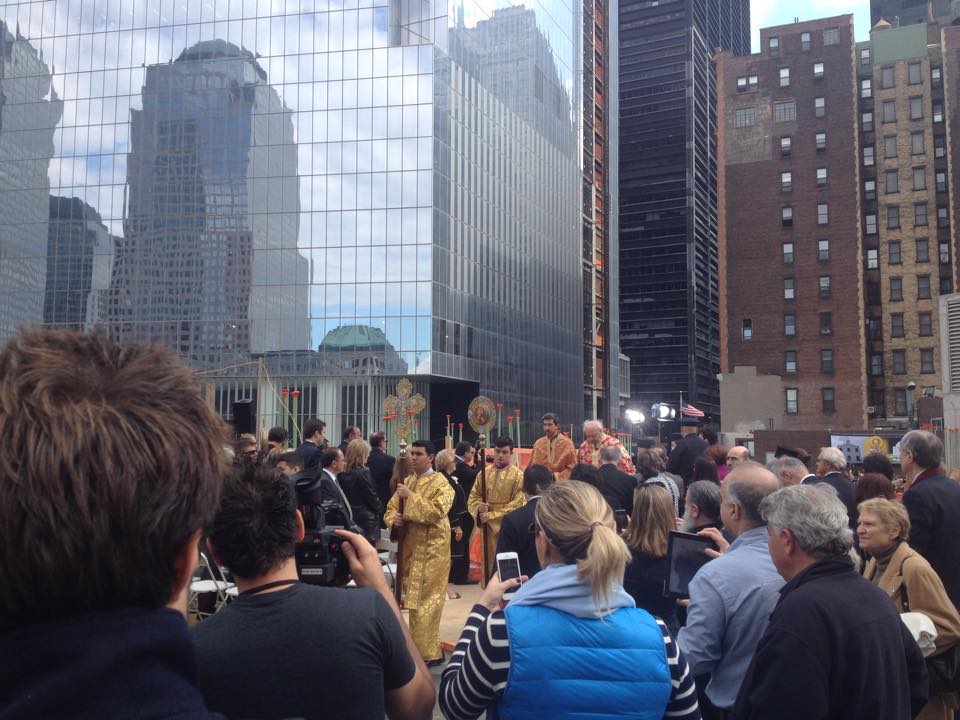Rebuilding St. Nicholas at Ground Zero: Can a community be rebuilt?
New York, NEW YORK -- On Oct. 18, thousands of members of the Greek Orthodox community gathered under a brilliant blue sky, listening as church officials blessed the ground where St. Nicholas church will be rebuilt. After years of haggling with city officials, the groundbreaking was a sign of progress for a church community eager to resume local presence.

St. Nicholas Church was a religious anchor for the neighborhood until it was destroyed when the World Trade Center’s South tower collapsed on Sept. 11, 2001. Archbishop Demetrios of America, the current archbishop of the Greek Orthodox Archdiocese of America and Exarch of the Atlantic and Pacific Oceans, recalled standing in a broken building right after the attack, in a room full of debris and human remains, the air thick and heavy. “We prayed...and said, this church should be rebuilt."
But the road to rebuilding was complicated. “It was easy to say,” recalled Georgios Patakis, former governor of New York. “It was harder to do.”
In 2008 the Port Authority of New York and New Jersey, which is in charge of overall rebuilding efforts at Ground Zero, signed an agreement to rebuild St. Nicholas, but shortly thereafter a dispute broke out, bringing plans to a four-year halt.
Up until 2001, this small Greek Orthodox Church offered members and locals alike a place of solace and peace amidst the fast-paced feverishness of the financial district. “On one side you have business and money,” said Eleni, an elderly woman from Brooklyn who attended the ceremony. “[A]nd on the other side you have St. Nicholas, a place where you can go and light a candle...it is beautiful.”
It was originally established as a congregation in 1916. Greek immigrants transformed a local tavern into a church and the whitewashed building, surrounded by a parking lot and located in the shadow of the World Trade Center, became home to a congregation of more than 70 families until its destruction. St. Nicholas was the only religious building destroyed during the attacks.
Since then, church leaders and congregants have been working for permission to rebuild. After signing their agreement with the Port Authority, who agreed to pay $20 million to erect a new church on Liberty Street, plans stopped in March 2008. The Port Authority accused the church of imposing exorbitant stipulations, while church leaders argued that the Port Authority independently withdrew from the agreement.
The leaders of St. Nicholas filed a legal claim against the Port Authority, accusing them of “arrogance, bad faith and fraudulent conduct” and claiming that they had excavated the church's property without permission.
However, under a 2011 agreement negotiated by former New York governor Andrew Cuomo, St. Nicholas agreed to drop its lawsuit in exchange for building at a larger site.
Though the church building was destroyed, the community of St. Nicholas remained intact, according to Father Constantinides. Almost immediately after the attacks of 9/11, the community of St. Nicholas began worshipping at Saints Constantine and Helen Cathedral, a Greek Orthodox church in Brooklyn. But they never lost their identity as a congregation: When they marched in the annual Greek Independence Day parade, they did so as the Church of St. Nicholas.
“If anything, this tragic event only brought them more together,” said Constantinides. “It shows that even in a small parish in lower Manhattan that people may not know existed, there’s a humanistic value, and that is what we see through the people who have fought for thirteen years to get us to where we are.”
During the Oct. 18 event, high-ranking members of the Greek Orthodox Church conducted the ceremony, basing it on the Old Testament practices of laying the cornerstone for a church. For St. Nicholas National Shrine, officials constructed cairns (a memorial compilation of stones) in imitation of the cairn at Gilgal that the prophet Joshua erected to commemorate the crossing over of the Israelites into the promised land. At the ceremony, two cairns were constructed in memory of the Twin Towers, which will eventually be stationed permanently at the entrance of the church.
The ceremony included hymns honoring Saint Nicholas, Scripture readings and prayers for families of victims killed during the attacks, the President, members of armed forces and New York’s governor and mayor. Among the crowd were Sen. Charles E. Schumer of New York and former officials including Mayor David N. Dinkins and Gov. George E. Pataki. Mr. Pataki, who left office in 2006, spoke about the initial commitment to rebuild and the difficult process that ensued, which included suing Port Authority when they wanted to reject plans to rebuild the church.
Senator Schumer focused on the victory that the rebuilding represented through the church’s difficult journey. “Like a phoenix rising from the ashes, this church will show the resilience and fortitude of St. Nicholas and of all New Yorkers.”
The church is estimated to open in 2016, the same year as the church’s 100th anniversary.
“The biggest...responsibility this community will have is...philoxenia,” Constantinides said, referring to a Greek word that he explained means being welcoming and offering fellowship. “There are people who will make St. Nicholas their permanent place of worship...there are people who are vacationing...but regardless of who enters St. Nicholas, the crucial aspect of philoxenia will continue.”




